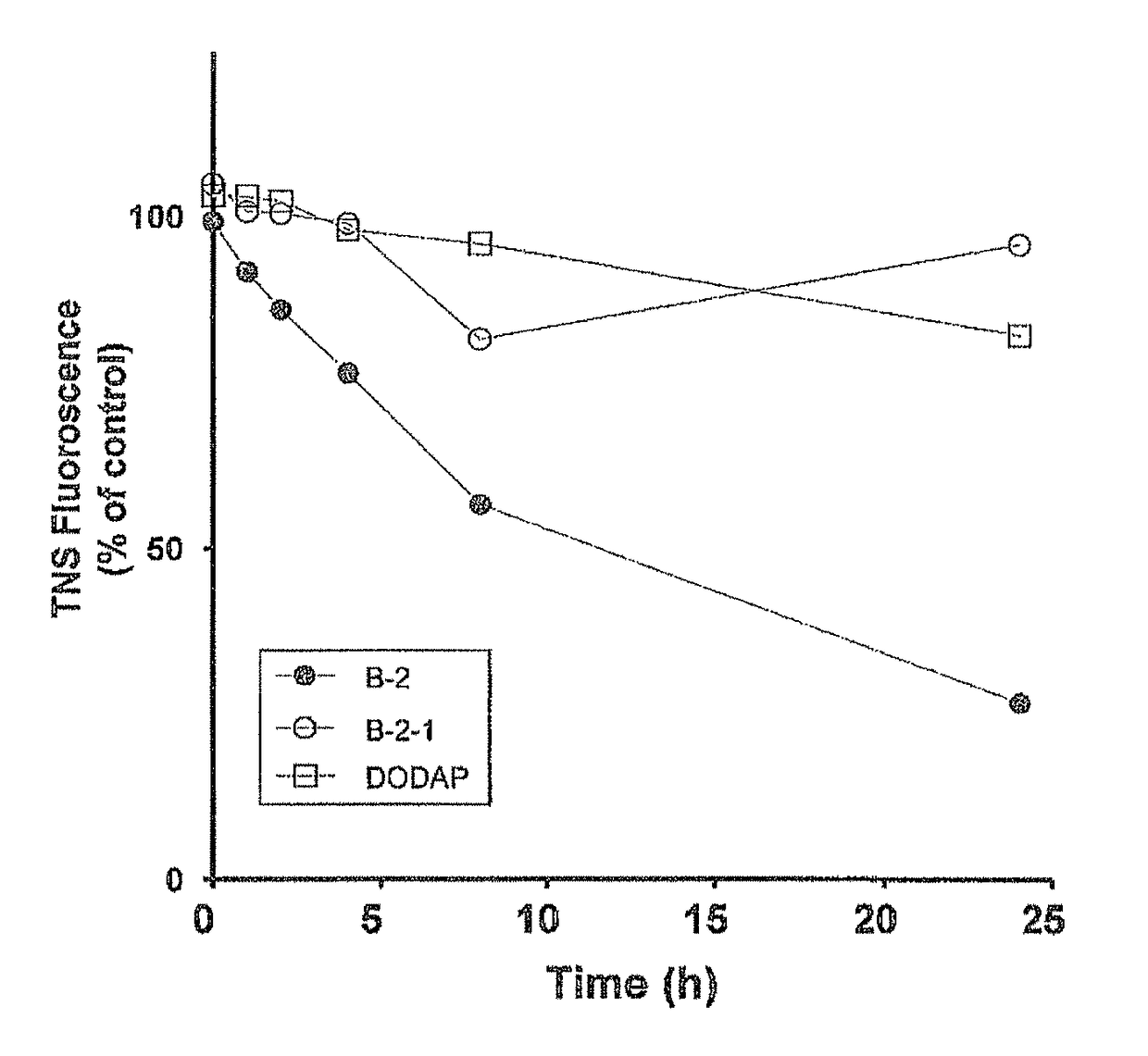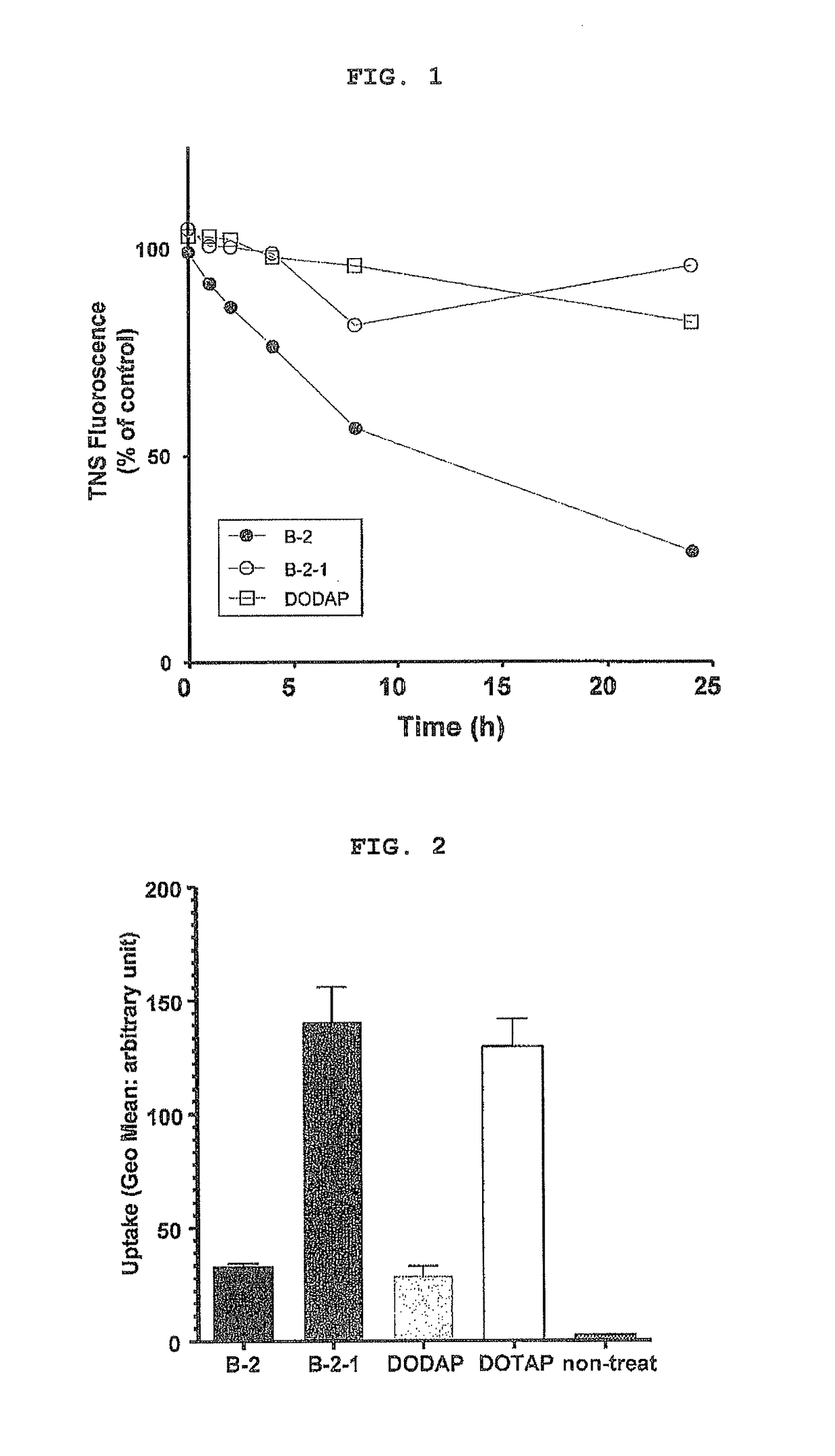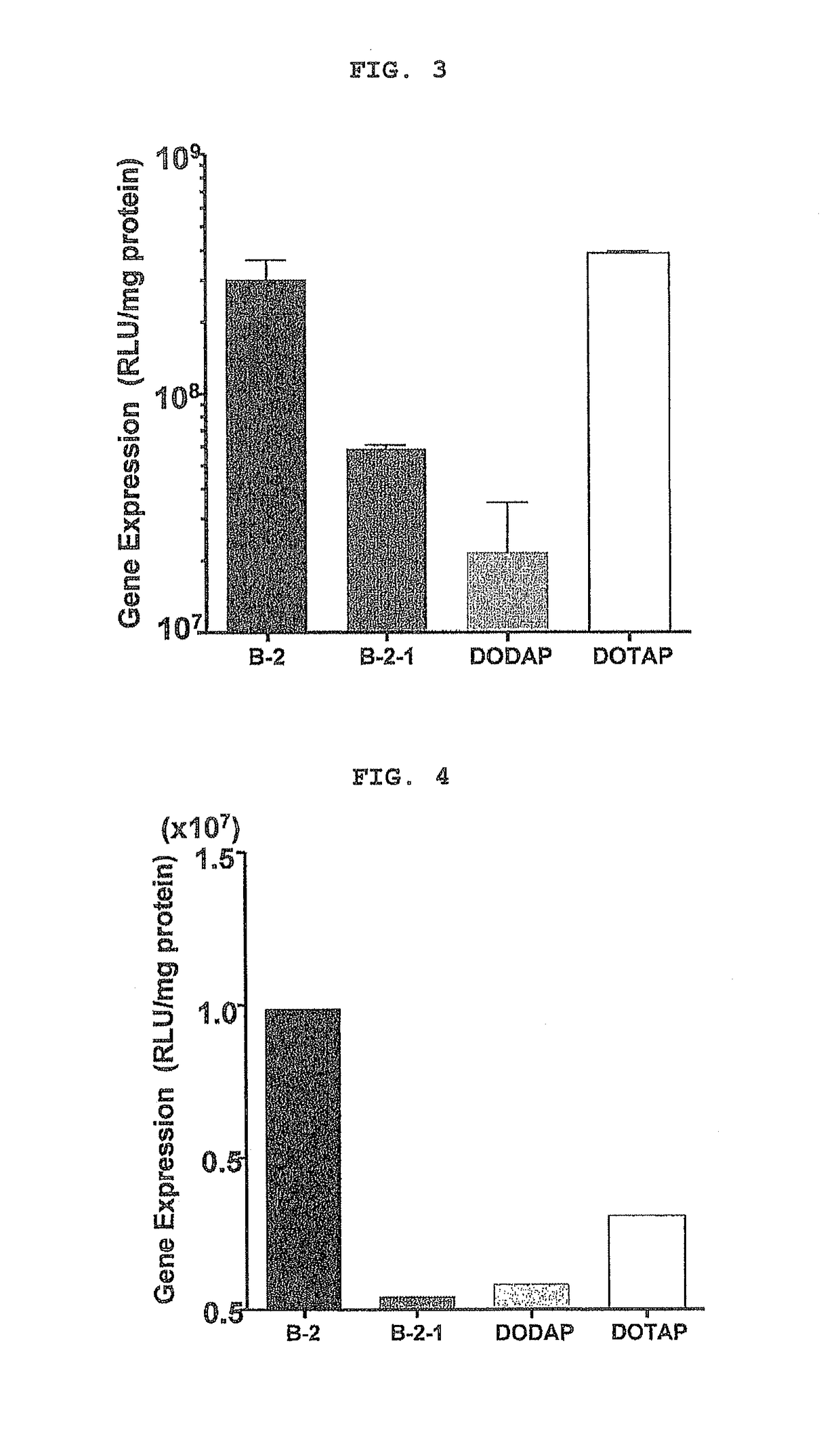Cationic lipid having improved intracellular kinetics
a cationic lipid and intracellular kinetic technology, applied in the direction of microencapsulation, pharmaceutical delivery mechanism, organic chemistry, etc., can solve the problems of unsatisfactory intracellular expression efficiency achieved by nucleic acid delivery carriers using conventional cationic lipids, and the safety aspect is not fully satisfied, so as to promote the release of encapsulated substances (nucleic acid), improve the intracellular expression efficiency per unit lipid membrane structure, and improve the effect of stability
- Summary
- Abstract
- Description
- Claims
- Application Information
AI Technical Summary
Benefits of technology
Problems solved by technology
Method used
Image
Examples
example 1
[Example 1] (Synthesis of B-2)
[0154]Acetonitrile (143 ml) was added to 2,2′-dithiodiethanol (manufactured by ACROS) (15 g, 97.2 mmol) and the mixture was dissolved at 20-25° C. Triethylamine (33.3 g, 328 mmol) was added and, after stirring at 20-25° C. for 5 min, methanesulfonyl chloride 34.5 g (300 mmol) was added under ice-cooling and the mixture was reacted at 20-25° C. for 3 hr. TLC analysis (eluent: chloroform / methanol=85 / 15 (v / v)) confirmed that a spot of the reaction product was obtained and the starting material 2,2′-dithiodiethanol disappeared, with which the reaction was terminated. The reaction was discontinued by adding ethanol (29 mL) to the reaction solution, and insoluble materials were filtered off using filter paper (5A). To the filtrate were added dichloromethane (150 ml) and 10% sodium bicarbonate water (150 g), and the mixture was stirred for 5 min, stood for 10 min and the aqueous layer was removed. To the organic layer was added water (150 g) and the mixture wa...
example 2
[Example 2] (Synthesis of B-2-2)
[0158]di-MAP compound (2.0 g, 6.7 mmol) and stearic acid (4.6 g, 16.2 mmol) were dissolved in chloroform (20 ml), and DMAP (0.33 g, 2.7 mmol) and 1-ethyl-3-(3-dimethylaminopropyl)carbodiimide hydrochloride (hereinafter EDC) (3.9 g, 20.3 mmol) were added. At 4 hr after the reaction, TLC analysis (eluent: chloroform / methanol=95 / 5 (v / v)) was performed. The results confirmed disappearance of di-MAP compound, with which the reaction was terminated. Thereafter, the reaction mixture was extraction-washed with 5% aqueous sodium bicarbonate (10 g), after which the aqueous layer was discarded. Then, to the recovered organic layer was added water (10 g) to wash the layer with water. The aqueous layer was discarded, and magnesium sulfate (0.4 g) was added to the organic layer to perform a dehydrating treatment. Insoluble materials were filtered off by filtration using Opuraito and filter paper (5A), and the solvent was evaporated by an evaporator to give an orang...
example 3
[Example 3] (Synthesis of B-2-3)
[0161]The di-MAP compound (2.0 g, 6.7 mmol) and linoleic acid (4.5 g, 16.0 mmol) were dissolved in chloroform (20 ml), and DMAP (0.33 g, 2.7 mmol) and EDC (3.9 g, 20.3 mmol) were added. At 4 hr after the reaction, TLC analysis (eluent: chloroform / methanol=95 / 5 (v / v)) was performed. The results confirmed disappearance of the di-MAP compound, with which the reaction was terminated. Thereafter, the reaction mixture was extraction-washed with 5% aqueous sodium bicarbonate (10 g), and the aqueous layer was discarded. Then, to the recovered organic layer was added water (10 g) to wash the layer with water. The aqueous layer was discarded, and magnesium sulfate (0.4 g) was added to the organic layer to perform a dehydrating treatment. Insoluble materials were filtered off by filtration using Opuraito and filter paper (5A), and the solvent was evaporated by an evaporator to give a diacylated compound (6.0 g) as an orange liquid.
[0162]The obtained liquid was p...
PUM
| Property | Measurement | Unit |
|---|---|---|
| reaction temperature | aaaaa | aaaaa |
| reaction temperature | aaaaa | aaaaa |
| reaction temperature | aaaaa | aaaaa |
Abstract
Description
Claims
Application Information
 Login to View More
Login to View More - R&D
- Intellectual Property
- Life Sciences
- Materials
- Tech Scout
- Unparalleled Data Quality
- Higher Quality Content
- 60% Fewer Hallucinations
Browse by: Latest US Patents, China's latest patents, Technical Efficacy Thesaurus, Application Domain, Technology Topic, Popular Technical Reports.
© 2025 PatSnap. All rights reserved.Legal|Privacy policy|Modern Slavery Act Transparency Statement|Sitemap|About US| Contact US: help@patsnap.com



